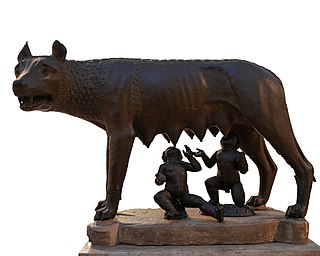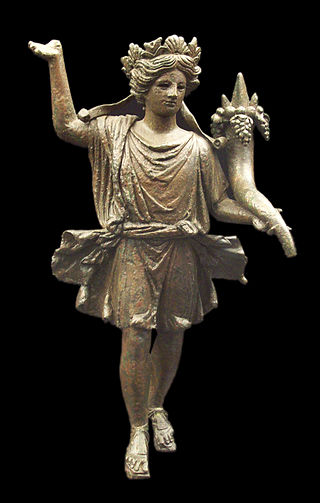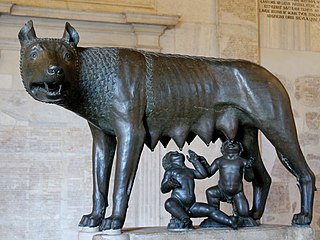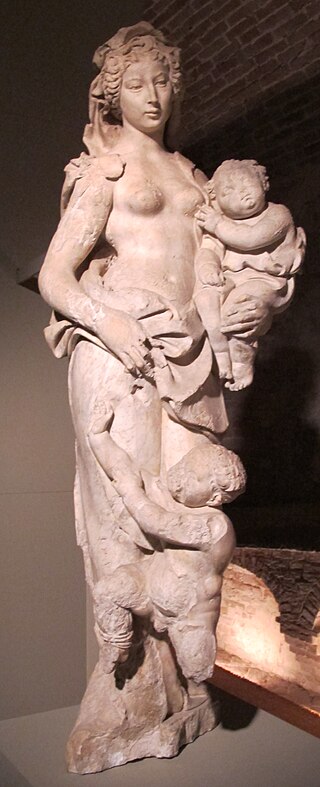
Acca Larentia or Acca Larentina was a mythical woman, later a goddess of fertility, in Roman mythology whose festival, the Larentalia, was celebrated on December 23. [1]

Acca Larentia or Acca Larentina was a mythical woman, later a goddess of fertility, in Roman mythology whose festival, the Larentalia, was celebrated on December 23. [1]
In one mythological tradition (that of Licinius Macer, et al.), Acca Larentia was the wife of the shepherd Faustulus. [2] And after Romulus and Remus were thrown into the Tiber river, Faustulus brought them back to his home, where Acca Larentia would raise the children. [3] She had twelve sons, and on the death of one of them Romulus took his place. [4] and with the remaining eleven founded the college of the Arval brothers (Fratres Arvales). [5] She is therefore identified with the Dea Dia of that collegium. The flamen Quirinalis acted in the role of Romulus (deified as Quirinus) to perform funerary rites for his foster mother. [6]
Another tradition holds that Larentia was a beautiful prostitute (scortum) of notorious reputation, roughly the same age as Romulus and Remus, during the reign of Ancus Marcius in the 7th century BCE. She was awarded to Hercules as a prize in a game of dice by the guardian of his temple, and locked in it with his other prize, a feast. When the god no longer had need of her, he advised her to marry the first man to proposition her as she stepped out that morning, who turned out to be a wealthy Etruscan named Carutius (or Tarrutius, according to Plutarch). Larentia later inherited all his property and bequeathed it to the Roman people. [3] Ancus, in gratitude for this, allowed her to be buried in the Velabrum, and instituted an annual festival, the Larentalia, at which sacrifices were offered to the Lares. [7] Plutarch explicitly states that this Larentia was a different person from the Larentia who was married to Faustulus, although other writers, such as Licinius Macer, relate their stories as belonging to the same individual. [8] [9]
Yet another tradition holds that Larentia was neither the wife of Faustulus nor the consort of Hercules, but a courtesan called lupa by the shepherds. Lupa literally means "she-wolf", although the word colloquially meant "prostitute". The legend also states that she left the fortune she amassed through prostitution to the Roman people. [3] [10]
Whatever may be thought of the contradictory accounts of Acca Larentia, it seems clear that she was of Etruscan origin, thus possibly connected with the worship of the Lares. [3] It is entirely possible her name may be derived from Lares. This relation is also apparent in the number of her sons, which corresponds to that of the twelve country Lares. [11] [12] Wiseman explores the connections among Acca Larentia, Lara, and Larunda in several of his books. [13] Acca Larentia has also been associated with another Roman Goddess named Dea Dia. [3]
Like Ceres, Tellus, Flora, and others, Acca Larentia symbolized the fertility of the earth, in particular the city lands and their crops. Acca Larentia is also identified with Larentina, Mana Genita, and Muta.
Acca is a character in David Drake's story "To Bring the Light", [14] [15] a reconstruction of Rome's beginnings around 751 BCE. She is depicted as a sympathetic village woman in the small shepherd community on Palatine Hill from which Rome would begin.

The founding of Rome was a prehistoric event or process later greatly embellished by Roman historians and poets. Archaeological evidence indicates that Rome developed from the gradual union of several hilltop villages during the Final Bronze Age or early Iron Age. Prehistoric habitation of the Italian Peninsula occurred by 48,000 years ago, with the area of Rome being settled by around 1600 BC. Some evidence on the Capitoline Hill possibly dates as early as c. 1700 BC and the nearby valley that later housed the Roman Forum had a developed necropolis by at least 1000 BC. The combination of the hilltop settlements into a single polity by the later 8th century BC was probably influenced by the trend for city-state formation emerging from ancient Greece.

In Roman mythology, Romulus and Remus are twin brothers whose story tells of the events that led to the founding of the city of Rome and the Roman Kingdom by Romulus, following his fratricide of Remus. The image of a she-wolf suckling the twins in their infancy has been a symbol of the city of Rome and the ancient Romans since at least the 3rd century BC. Although the tale takes place before the founding of Rome around 750 BC, the earliest known written account of the myth is from the late 3rd century BC. Possible historical bases for the story, and interpretations of its local variants, are subjects of ongoing debate.
In Roman mythology, Tarutius or Tarrutius was a wealthy merchant married to Acca Larentia. According to Plutarch's Life of Romulus, the keeper of the Temple of Hercules challenged the hero to a game of dice with Hercules to receive a night with a beautiful woman and a fine spread and the god to provide the temple keeper with a valuable gift if the keeper was successful.

In Roman mythology, Faustulus was the shepherd who found the infant Romulus and his twin brother Remus along the banks of the Tiber River as they were being suckled by the she-wolf, Lupa. According to legend, Faustulus carried the babies back to his sheepfold for his wife Acca Larentia to nurse them. Faustulus and Acca Larentia then raised the boys as their own. Romulus later defeated and killed King Amulius of Alba Longa, with the help of Faustulus, and his brother Pleistinus. Romulus and Remus set out to build their own city, but then had a falling out. In the ensuing skirmish, Faustulus and Pleistinus were killed. Romulus went on to found Rome

In Roman mythology, Amulius was king of Alba Longa who ordered the death of his infant, twin grandnephews Romulus, the eventual founder and king of Rome, and Remus. He was deposed and killed by them after they survived and grew to adulthood.

In Roman mythology and religion, Quirinus is an early god of the Roman state. In Augustan Rome, Quirinus was also an epithet of Janus, as Janus Quirinus.

The Aventine Hill is one of the Seven Hills on which ancient Rome was built. It belongs to Ripa, the modern twelfth rione, or ward, of Rome.

According to the Roman foundation myth, Titus Tatius, also called Tatius Sabinus, was king of the Sabines from Cures and joint-ruler of the Kingdom of Rome for several years.

Maia, in ancient Greek religion and mythology, is one of the Pleiades and the mother of Hermes, one of the major Greek gods, by Zeus, the king of Olympus.

Gaius Licinius Macer was a Roman annalist and politician.
The Roman festival of Larentalia was held on 23 December but was ordered to be observed twice a year by Augustus; by some supposed to be in honour of the Lares, a kind of domestic genii, or divinities, worshipped in houses, and esteemed the guardians and protectors of families, supposed to reside in chimney-corners. Others have attributed this feast in honour of Acca Larentia, the nurse of Romulus and Remus, and wife of Faustulus. During this festival, offerings were made to the dead, usually at altars dedicated to Acca Larentia. A sacrifice was typically offered in the Velabrum, the spot where Acca Larentia is buried. Larentalia was part of a series of ancient Roman festivals and holidays celebrating the end of the old year and the start of the new.

The Ficus Ruminalis was a wild fig tree that had religious and mythological significance in ancient Rome. It stood near the small cave known as the Lupercal at the foot of the Palatine Hill and was the spot where according to tradition the floating makeshift cradle of Romulus and Remus landed on the banks of the Tiber. There they were nurtured by the she-wolf and discovered by Faustulus. The tree was sacred to Rumina, one of the birth and childhood deities, who protected breastfeeding in humans and animals. St. Augustine mentions a Jupiter Ruminus.

Lares were guardian deities in ancient Roman religion. Their origin is uncertain; they may have been hero-ancestors, guardians of the hearth, fields, boundaries, or fruitfulness, or an amalgam of these.

Romulus was the legendary founder and first king of Rome. Various traditions attribute the establishment of many of Rome's oldest legal, political, religious, and social institutions to Romulus and his contemporaries. Although many of these traditions incorporate elements of folklore, and it is not clear to what extent a historical figure underlies the mythical Romulus, the events and institutions ascribed to him were central to the myths surrounding Rome's origins and cultural traditions.

In ancient Roman religion, the Flamen Quirinalis was the flamen or high priest of the god Quirinus. He was one of the three flamines maiores, third in order of importance after the Flamen Dialis and the Flamen Martialis. Like the other two high priests, he was subject to numerous ritual taboos, such as not being allowed to touch metal, ride a horse, or spend the night outside Rome. His wife functioned as an assistant priestess with the title Flaminicia Quirinalis.

The Mother of the Lares has been identified with any of several minor Roman deities. She appears twice in the records of the Arval Brethren as Mater Larum, elsewhere as Mania and Larunda. Ovid calls her Lara, Muta and Tacita.

Gnaeus Gellius was a Roman historian. Very little is known about his life and work, which has only survived in scattered fragments. He continued the historical tradition set by Fabius Pictor of writing a year-by-year history of Rome from mythological times to his day. However, with about a hundred books, Gellius' Annales were massively more developed than the other Roman annalists, and was only surpassed by Livy's gigantic History of Rome.

In the Roman foundation myth, a she-wolf was an Italian wolf who nursed and sheltered the twins Romulus and Remus after they were abandoned in the wild by decree of King Amulius of Alba Longa. She cared for the infants at her den, a cave known as the Lupercal, until they were discovered by a shepherd, Faustulus. Romulus would later become the founder and first king of Rome. The image of the she-wolf suckling the twins has been a symbol of Rome since ancient times and is one of the most recognizable icons of ancient mythology.

Remoria is a place associated with the legendary founding of Rome by Romulus and Remus where, according to Roman tradition, Remus saw six birds land and which he chose as an auspicious location for the future city. Some variants of the legend say that Remoria was also the place where Remus was buried after he was killed by Romulus.
over 2,500 deities of the world
{{cite book}}: CS1 maint: location missing publisher (link)![]() This article incorporates text from a publication now in the public domain : Smith, William, ed. (1870). "Acca Larentia". Dictionary of Greek and Roman Biography and Mythology .
This article incorporates text from a publication now in the public domain : Smith, William, ed. (1870). "Acca Larentia". Dictionary of Greek and Roman Biography and Mythology .